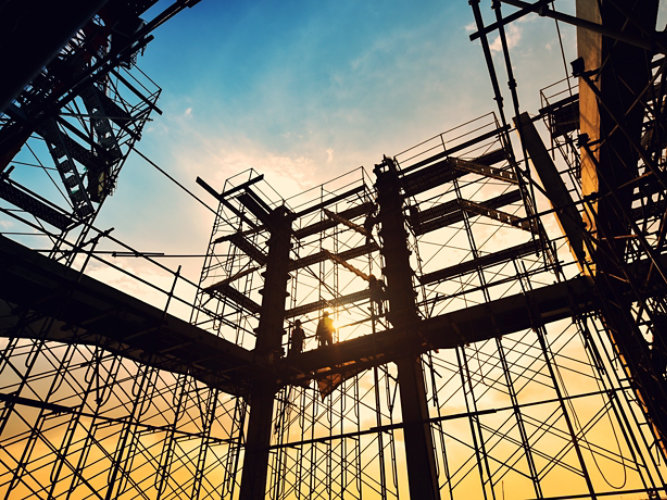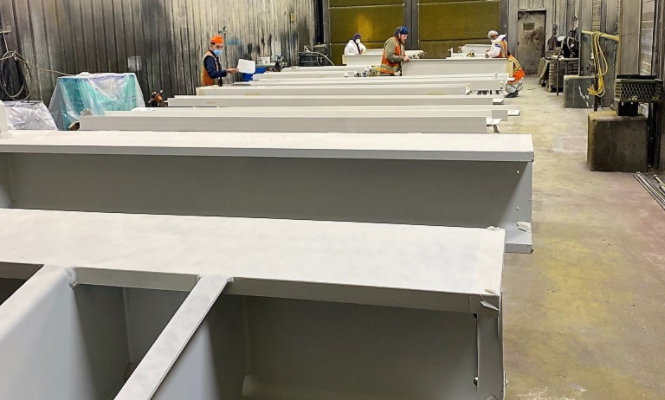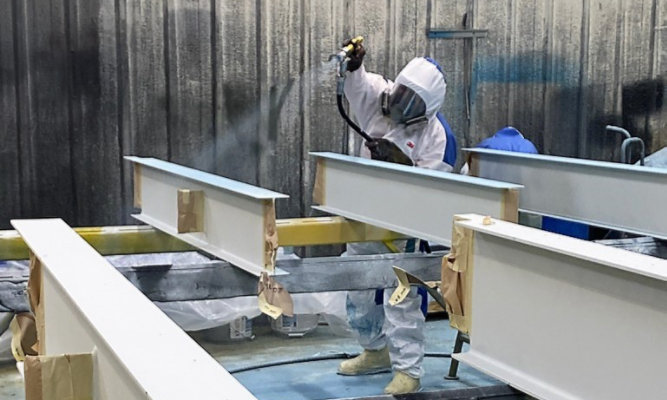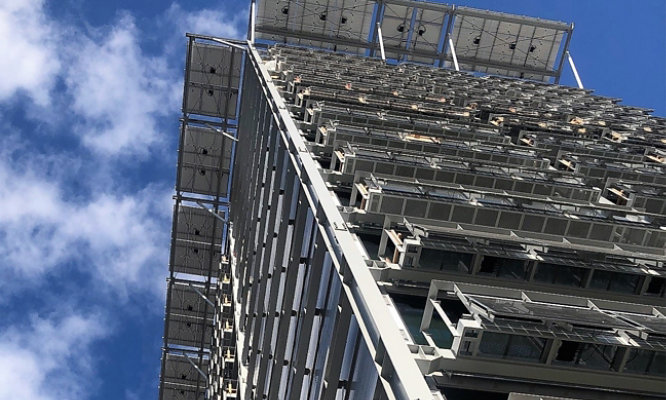Shop-Applied Fireproofing vs Field-Applied Fireproofing: How Shop-Applied Fireproofing Beats Field Applications
Enhance Quality, Aesthetics and Safety with Shop-Applied Fireproofing
Find this article on page 18 of our custom publication, Market Pulse - Advancements in Coatings Technology, featuring industry trends and thought leadership.

The Shift in Applying Passive Fire Protection Coatings in the Shop Compared to Coating Steel in the Field
The practice of where and when to fireproof structural steel for buildings, hotels, stadiums and other multi-story structures has evolved significantly around the globe over the past several decades. Today, steel fabricators, general contractors, asset owners and architectural designers are realizing lower costs and enhanced safety, quality and aesthetics. These benefits can be directly tied to a shift from applying passive fire protection (intumescent) coatings in the field to applying them in a controlled shop environment. And stakeholders who have not yet made the shift are missing out on streamlined operations and lower overall costs.
Shop-Applied Fireproofing vs Field-Applied Fireproofing: The History
Major fabricators in the United Kingdom started applying passive fire protection coatings to structural steel within the shop environment—as opposed to within the construction zone—around the late 1990s/early 2000s. Soon afterward, the steel fabrication and construction industries began embracing fireproofing in the shop as a standard business model. It is now widely adopted in the U.K. and much of Europe, the Middle East and Asia.
Compared to the application of passive fire protection coatings in the field—which is relatively common in the United States—fireproofing in the shop enables stakeholders to reduce costs and enhance the overall quality of applications. The gains realized in the U.K. and other parts of Europe make a viable case for major U.S. fabricators to adopt a similar strategy in greater numbers, so the myriad cost, safety and aesthetic benefits derived from the shop-applied model become more widespread across North America.
Shop-Applied Fireproofing vs Field-Applied Fireproofing: Time & Cost
One important advantage of restricting the fire protection process to the shop environment is that it allows the construction team to complete buildings much faster, lowering costs for builders. This swifter speed-to-completion is made possible by eliminating the need for much of the equipment and hassle associated with coating steel after it has been erected within a structure.
With coatings already applied in the shop, applicators do not need to set up a full containment system around the steel structure to protect the substrate from dust, rain and snow prior to coating. Nor do they have to invest in setting up environmental controls to ensure conditions are suitable for applying coatings. The containment process alone can be time-intensive and cost-prohibitive. Plus, within the shop, applicators can control temperatures and humidity to fireproof steel during any season of the year.
Shop-Applied Fireproofing vs Field-Applied Fireproofing: Application Quality
Applying passive fire protection within a controlled shop also improves the overall quality of the surface preparation and the coating application. To begin with, it is much easier for coating applicators to prepare each piece of steel in the shop, as opposed to the more haphazard process of coating assembled steel structures, which can contain tight corners and other difficult-to-reach areas. During field application, applicators run the risk of working with an imperfect surface preparation, which can compromise the quality of the fireproofing process.
By contrast, when spraying intumescent coatings in the shop, applicators can control the surface preparation and enhance the quality of the fire protection application, which thereby improves safety for building occupants. For example, applying fireproofing in the shop helps applicators better ensure that coatings are applied to the right thickness for each piece of steel and that the entire structure therefore conforms to the specified fire resistance rating.
Another significant benefit of applying the coatings in an indoor controlled environment—as opposed to in the construction zone—is that it removes the necessity of coating the steel while other tradesmen are working. Fireproofing in the shop reduces the number of trades that must operate simultaneously on a construction site. Doing so enhances safety for the roofers, plumbers, electricians, excavators and other tradesmen laboring at the site. When coating applicators are working simultaneously with others, the process can be inefficient and hazardous. Accidents are more likely to happen.
Table 1. Shop-Applied Fireproofing vs Field-Applied Fireproofing
Shop-Applied Fireproofing |
Field-Applied Fireproofing |
Controlled shop environment |
Uncontrolled, variable environment |
Containment inherent within shop |
Containment required onsite |
Faster fireproofing applications |
Longer fireproofing applications due to site setup |
Easier surface preparation |
More challenging surface preparation |
Uniform coating applications and thicknesses |
Potential for varied applications and thicknesses due to limited access and maneuverability when steel is erected |
Faster building completion due to limited on-site touch-up application needs |
Longer construction timelines due to downtime for other trades working on site while applying coatings |
Greater design freedom |
More limited design freedom due to inability to achieve precise coating applications on site |
Advancing Innovation in Building Design with Shop-Applied Fireproofing
Given the cost, quality control and long-term safety benefits of using shop-applied passive fire protection coatings, this controlled application process has an added benefit for architects. It frees them up to incorporate more steel into building designs, allowing them to be more innovative. Sherwin-Williams witnessed such architectural creativity while working with its construction partners to fireproof the Leadenhall Building and the Shard of Glass skyscrapers in central London.
In fact, a unique fire protection challenge occurred while collaborating with architects and engineers during the construction of the Leadenhall Building, a modern glass and steel structure. Many of the iconic building’s design elements—its beams, columns and large transitional nodes within a sloping mega-frame—were highly complex. The team needed to develop precise intumescent coating thickness specifications for each piece of steel, depending on its size and incorporation into the structure.
Our fire engineering team engaged in painstaking and complex fire protection analysis and coating application methodology in conjunction with the project’s structural steel specialist. This process yielded specific coating thickness guidelines for each piece of steel. Then, by applying the coatings in a shop environment, the fabricator was able to ensure the Leadenhall Building’s unusual design elements had the appropriate thickness of coatings applied and therefore the highest level of fire protection.
A greater percentage of construction companies in the U.S. could benefit from adopting the shop-applied fireproofing model that is now prevalent in the U.K. By embracing the shop-applied approach, major fabricators in the U.S. are sure to see a difference in the quality of the coated steel used during construction, while passing a host of benefits down the construction chain.
Contact Sherwin-Williams for Shop-Applied Passive Fire Protection Coatings
At Sherwin-Williams, we are committed to protecting steel structures and providing life-saving protection from fires. Our line of proven intumescent fireproof coating systems can be applied off-site, resulting in additional quality control, lower overall cost and better aesthetics.
To learn more about our intumescent fire protective coatings, contact a Sherwin-Williams representative today.
Discover More
Industry Expertise and Innovation
See how we help customers find customized solutions for their project and application challenges.
Our Fire Protection Expertise
Explore our industry solutions and technology to help protect your assets.
LEARN MOREProduct Lookup
Find out more about our innovative coatings for a variety of industries.
FIND A PRODUCT

